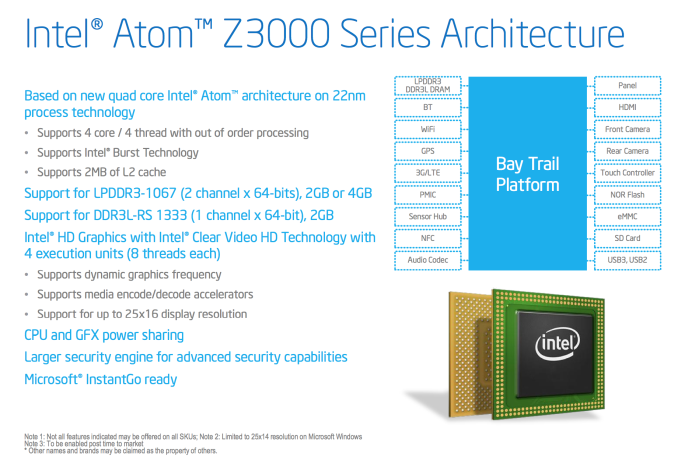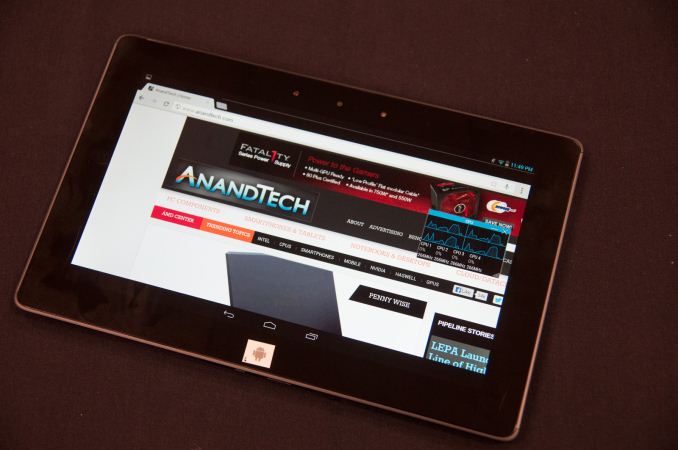The Bay Trail Preview: Intel Atom Z3770 Tested
by Anand Lal Shimpi & Brian Klug on September 11, 2013 12:00 PM ESTFinal Words
At its Silvermont disclosure, Intel promised performance better than any other ARM based core in the market today. Looking at our Android results, Intel appears to have delivered on that claim. Whether we’re talking about Cortex A15 in NVIDIA’s Shield or Qualcomm’s Krait 400, Silvermont is quicker. It seems safe to say that Intel will have the fastest CPU performance out of any Android tablet platform once Bay Trail ships later this year.
The power consumption, at least on the CPU side, also looks very good. From our SoC measurements it looks like Bay Trail’s power consumption under heavy CPU load ranges from 1W - 2.5W, putting it on par with other mobile SoCs that we’ve done power measurements on.
On the GPU side, Intel’s HD Graphics does reasonably well in its first showing in an ultra mobile SoC. Bay Trail appears to live in a weird world between the old Intel that didn’t care about graphics and the new Intel that has effectively become a GPU company. Intel’s HD graphics in Bay Trail appear to be similar in performance to the PowerVR SGX 554MP4 in the iPad 4. It’s a huge step forward compared to Clover Trail, but clearly not a leadership play, which is disappointing.
The big unknowns are things like video decode power efficiency, perf and quality of their ISP and idle power efficiency vs. Qualcomm.
Bay Trail looks like a good starting point for Intel in mobile, and the performance of Silvermont makes me excited for Merrifield in phones next year. What Intel needs to do going forward is simply continue to iterate and execute for the next few generations after Bay Trail and it will have a real chance at success in mobile.
My biggest concern is about the design wins we see based around Bay Trail. Although Intel is finally in a spot where it can be in devices on the market, none of those devices thus far have been any good. Bay Trail is attractive enough to garner more design wins for certain, the question is whether or not the quality of those wins will improve as well. In the tablet market there’s the iPad and the Nexus lines that are really the most interesting, and I don’t expect Bay Trail to be in either. Whether or not the quality of the rest goes up this generation and we find a Bay Trail in one of those devices remains to be seen.












190 Comments
View All Comments
drothgery - Friday, September 13, 2013 - link
Some Silvermont-core based chips will have Pentium or Celeron branding, FWIW.phoenix_rizzen - Monday, September 16, 2013 - link
Yeah, because "Celeron" is so much better when it comes to the "everyone knows it's horrible" viewpoint. And "Pentium" has become so overloaded as to be meaningless.To be honest, Intel needs to just eliminate the Atom, Celeron, and Pentium brands, and add a new Core i1 series to replace it.
NotaFanBoy - Wednesday, September 25, 2013 - link
+1hakime - Thursday, September 12, 2013 - link
"Intel’s HD graphics in Bay Trail appear to be similar in performance to the PowerVR SGX 554MP4 in the iPad 4."It's really a bold affirmation given that from your own numbers the Bay trail is significantly slower than the PowerVR SGX 554MP4 in all but one test.
HisDivineOrder - Thursday, September 12, 2013 - link
I think Intel needs to make a big, big push to get a Bay Trail chip into a Google Nexus product of some kind (possibly to let Google iterate on the OS a bit with regards to x86 CPU's), which was the original reason for Nexus btw.I also think Intel needs to convince MS with extremely low cost chips to make a Surface with Windows 8 and Bay Trail. Just dump Surface based on RT or knock it down to rock bottom pricing. Like $99 for Surface RT, $199 for Surface Pro Bay Trail, $499 for Surface Pro I3, $699 for Surface Pro I5, and $999 for Surface Pro I7 with Iris 5200.
That's if they insist on keeping RT around rather than just fold its development into Windows Phone, merge the two, and quietly take RT as a tablet OS around back behind the shed where the sun is just coming up over the trees, where the wind is blowing a little, and MS tells RT for tablets to look out through the trees.
Birds would start and fly away suddenly as a gunshot echoes.
Sad, but knowing it was for the best, MS could take the remains of RT to frankenstein-stitch into Windows Phone. It's not like it'd be the first time they rebooted a phone OS AND not the first time they stitched unrelated things together into a new product.
dwade123 - Thursday, September 12, 2013 - link
GPU is still Intel's Achilles Heel.Hrel - Thursday, September 12, 2013 - link
Seems they are weakest in GPU, as usual. I'd like to know why in one test they get clobbered by the Nvidia shield for Physics but then in another physics test the clobber Nvidia. Same thing happens with graphics. You'd think they'd be consistently better/worse at one or the other.With Nvidia releasing their first "real" mobile GPU soon (Q2 2014 I believe) Intel is going to have to at least double GPU performance in under a year to stay competitive. I doubt they can do that.
With that said, I really hope 3rd party OEM's starting using Bay Trail's CPU but packaging an Nvidia GPU.
It really is too bad Intel and Nvidia had that falling out over who buys who and is worth what and all that. If they were working together, the best CPU engineers with the best GPU engineers, just think what could have been.
nofumble62 - Thursday, September 12, 2013 - link
"With Nvidia releasing their first "real" mobile GPU soon (Q2 2014 I believe) Intel is going to have to at least double GPU performance in under a year to stay competitive. I doubt they can do that"I thought they have tripled the graphic performance of CloverTrail.
snarfbot - Thursday, September 12, 2013 - link
would it be possible in the future to put each devices soc in parenthesis or something in the charts, ideally with nominal frequencies, core count etc. that way it would be possible to evaluate comparable products from other manufacturers that you didnt directly review.like shield (tegra 4, a15 quad/1.9ghz, 72core/??mhz..) something like that. also even though this is a tablet review they still use largely the same hardware as smartphones, so it would make comparing actual hardware alot easier. even considering something like the moto x, with the frequency information next to the cores its performance would make sense relative to the rest of the products on the graph.
as it is now, you cant really draw any conclusions unless you cross reference the items listed with their specs on wikipedia or even worse random android forums.
so please please please, more info please.
sanketh - Friday, September 13, 2013 - link
I am just curious, Why does anand tech use the base frequency when intel is advertising its baytrail with the boosted frequency? Is the boost disabled? Can you provide system configurations for the Windows 8.1 benchmarking?